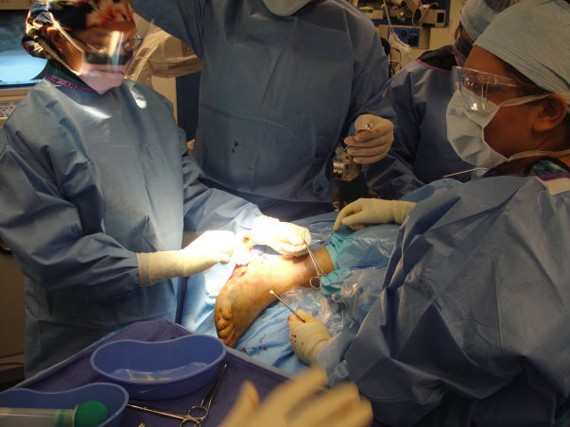Introduction Hallux Rigidus
Hallux Rigidus is a degenerative-type arthritis condition that affects
the large joint at the base of the great toe. A degenerative arthritis is a condition which results
from wear and tear on the joint surface over time. The condition may follow
an injury to the joint or, in some cases, may arise without a well defined
injury.
Anatomy – Hallux Rigidus
The joint at the base of the great toe is called the “metatarsal-phalngeal”
or MTP joint. Like any other joint in the body, the joint is covered with
articular
cartilage, a very slick shiny covering on the end of the bone. If this
material is injured, it begins a slow process of “wearing out”
or degeneration.
This can result in a wearing away of the articular surface, until raw
bone rubs against raw bone.
Bone spurs form around the joint as part of the degenerative
process. The spurs may restrict the motion in the joint, especially
the ability of the toe to bend upward when the foot moves forward.
Symptoms – Hallux Rigidus
The degeneration causes two problems – pain and loss of motion in the MTP joint. Without the ability
of the MTP to move enough to allow the foot to roll through while walking, the gait is painful and difficult.
Diagnosis -Hallux Rigidus
Diagnosis is usually apparent on examination, but xrays
are usually required to appreciate the extent of the degeneration
and the bone spur formation.
Medical Treatment -Hallux Rigidus
Treatment begins with anti-inflammatory medications to control the inflammation
of the degenerative arthritis. Special shoes that reduce the amount of
bend in the toe during walking will also help the symptoms initially.
A rocker type sole allows the shoe to take some of the bending force,
and may be combined with a metal brace in the sole to limit the flexibility
of the sole of the shoe and reduce the motion needed in the MTP joint.
Injection of cortisone into the joint may give temporary relief of symptoms.
Surgery – Hallux Rigidus

Surgery may be suggested if all else fails. Several types of procedures
are useful in this condition.
Arthrodesis:
Many surgeons favor fusion of the MTP joint to relieve the pain. This
results in a joint that no longer moves, and a rocker sole shoe is usually
necessary to improve the gait following this type of procedure.
An incision
is made into the MTP joint. The joint surfaces of the MTP joint are removed.
The two surfaces are then fixed with either a metal
pin or screw, with the toe turned slightly upward to allow for walking.
The bones are allowed to grow together, or fuse. The fusion usually takes
about three months to become solid.
Arthroplasty:
Some surgeons favor replacing the joint with an artificial joint, similar
to what is done in the knee or hip – only much smaller.
In this procedure, one of the joint
surfaces is removed and replaced with a plastic surface. This procedure
may relieve the pain AND preserve the joint motion. The major drawback
to this procedure is that the artificial joint probably will not last a
lifetime and will require more operations later if it begins to fail.